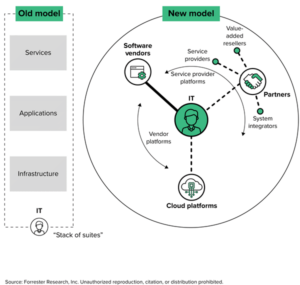The Right Platform Strategy Is Key To Your Future Fitness
Future fit businesses are more successful. Forrester finds that future fit companies grow 2.7 times faster than their peers. But it takes a lot to become future fit, and most companies have a ways to go. One key pillar of a future fit business? The right underlying technology, anchored by modern platforms.
While software platforms are nothing new, fundamentally different options and approaches are now possible due to the rise of cloud and modern computing architecture. Specifically, modern platform strategy revolves around:
• Prioritizing modern, versionless platforms that ease integration and innovation. Modern platform strategy should revolve around the cloud. With versionless solutions, future fit businesses benefit from a faster pace of vendor-delivered innovation, plus greater ability to leverage innovation from peers and ecosystem partners — since everything is made for and relevant to your version.
• Focusing differentiation in high-value areas. Leading technology executives recognize that the best way to gain speed and agility is to leverage existing solutions where they make sense. While you need to watch out for digital sameness, there are lots of areas where you don’t need to reinvent the wheel, such as accounting and finance. Even in areas that do differentiate you, make sure to separate which technology elements must be unique for differentiation; for example, your people are a likely differentiator, but payroll to support those people is not.
• Customizing and composing your “secret sauce,” with agility in mind. To create your unique differentiation, use modern techniques rather than traditional, time-consuming, difficult-to-sustain ones. Specifically, use low-code and no-code development, and assemble existing add-ons from marketplaces rather than trying to build everything with slow-pace, traditional development efforts.
Identify The Key Trusted Parties In Your Future Fit Platform Strategy
Technology executives have long depended on trusted, strategic partnerships but now must evolve their thinking to focus on ecosystems and interconnectivity between partners and achieve desired-but-elusive co-innovation with strategic partners (see the figure below). Key recommendations include:
• Evolving your sourcing approach to one-to-many rather than one-to-one. Make sure to think about ecosystems and partnerships when picking and managing strategic partners. Look at elements like app stores, bundling options, and ready-made partner add-ons — including looking at how partnerships are managed and vetted.
• Modernizing your thinking about competition versus collaboration. Many companies — especially those that take a conservative approach to privacy — worry about sharing anything with competition. However, modern trust networks include other customers and even those that may be your competitors, such as the anonymous benchmarking that a firm like Workday can offer through its data insights services.
• Leaning on public sources of information to jump-start your decisions. Use app store ratings, third-party sources of information (such as uptime benchmarks), and prevetted contracts (such as the Amazon Web Services marketplace standard contract) to speed up your own work on security and vetting. This does not mean you can wash your hands of the work but rather that you can and should be smarter about what work you need to do while leaning on existing sources of information.

For more information on platforms, please check out our recent report “Drive Alignment And Accelerate Transformation With Platforms.” And, to learn more about the critical role of partners, please read “Co-Innovation Partnerships Define Your Future Fit Vendor Strategy.”
We look forward to continuing the conversation!
Liz Herbert (eherbert@forrester.com)
